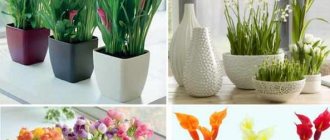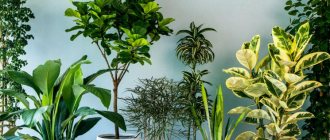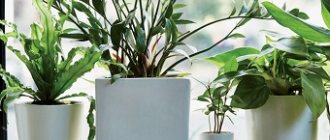The main factor in the development of any plant is a sufficient level of light. Lighting is necessary for photosynthesis (that is, nutrition and increase in green mass) and photomorphogenesis (growth of seeds, roots, fruits). These processes require light with different characteristics.
In nature, sunlight contains all the necessary rays, and the plant gets what it needs. In home and industrial conditions (for example, for greenhouses), illumination must be maintained artificially. To create an optimal light flux, it is recommended to use special phytolamps.
Contents
What is a phytolamp
A phytolamp is a special light source that emits a certain spectrum of radiation that helps the growth and development of plants. These include lamps that give the most natural light, i.e. light close to the sun.
Diagram of the dependence of processes in plants on wavelength
The diagram shows that the intensity of photosynthesis and photomorphogenesis occurs most fully at different wavelengths of light. Chlorophyll also “loves” its wavelength. By the way, it comes in two types: A and B.
Spectrum for chlorophyll A and B
Chlorophyll A is the main source of plant nutrition. Chlorophyll B accelerates the growth of above-ground green mass.
From both diagrams it is clear that the most useful spectra for plants will be blue (420-460 nm) and red (630-670 nm). These are the spectral ranges that the phytolamp provides.
Features of lamps for plants
Spot lighting
Phytolamps are designed to illuminate plants, including seedlings, in winter and early spring. The meager winter light is not enough for healthy development. And illuminated plants develop correctly:
- They absorb chlorophyll A and B, which promotes root growth and overall plant nutrition.
- The root system develops well.
- Metabolic processes are accelerated.
- Improves plant immunity and appearance.
Phytolamps are energy-saving devices. They consume an order of magnitude less energy compared to conventional lamps. This applies to phytolamps made on the basis of LED lamps.
Long service life is also one of the benefits of plant lamps. On average it lasts up to 100,000 hours of continuous use. Of course, no one uses phytolamps continuously: plants need to rest in the dark at night.
Special lamps for flowers are safe for plants: they heat up to only 55⁰C. Therefore, they need to be placed at a short distance.
Lighting for indoor plants
In winter, natural light is not enough for almost all house plants. Even on south-facing windows there is little light on short, cloudy days. Some domestic flowers are able to adapt to such conditions and even bloom in winter (Kalanchoe, Saintpaulia, poinsettia, Schlumbergera, chrysanthemum, Erica), but most species lose their decorative effect, stretch out towards the meager light from the window, many simply stop growing (dracaenas, peperomias, many orchids).
It is important to understand that both the intensity of lighting and the length of daylight matter. Many plants are able to bloom only with sufficient daylight (campanula, fuchsia, gardenia, oleander). Almost all orchids that do not have a winter dormant period need additional lighting in winter.
To extend daylight hours and increase the intensity of lighting, I use artificial lighting lamps, and also use some little tricks.
Choosing a phytolamp
When choosing a light source for plants, check:
- Lamp shape. For a window sill or a long shelf, you should choose a linear lamp. If you need to illuminate one pot or a small area on a shelf, then it is better to choose a base phytolamp.
- Range. The values of the optimal wavelengths for growing plants have already been mentioned: 420-460 and 630-670 nm. It is worth checking whether the lamp provides such ranges. This can be done by looking at the spectrogram on the packaging. On the spectrogram you need to look for peaks in the blue and red parts of the spectrum.
Spectrogram
It is better if the peak in the blue region is at 440-450 nm, and in the red region - 650-660 nm. If there is a strong deviation from the optimal spectrum values, you should not buy a lamp.
- Power. For indoor plants and seedlings, a good option is a lamp with a rated power of at least 25-30 W. It is worth keeping in mind that manufacturers must indicate the rated and real power, and the real one should be less. This is a sign of a quality lamp.
- The ratio of power, illuminated area and height at which the lamp is suspended. Let's start with the fact that as the height doubles, the luminous flux decreases by 4 times. The more powerful the lamp, the higher it can be hung. For example, a LED lamp with a length of 50 cm and a power of 25 W is recommended to be hung at a height of 15-30 cm. And a similar device with a power of 50 W is recommended to be hung at a height of 20-50 cm.
- The area of the lamp radiator. The larger the area, the better the cooling will be, the longer the phytolamp will last.
- The material from which the lamp is made. A good choice is an aluminum body. The advantage is that aluminum also serves as a radiator for LEDs. It is not recommended to take a lamp with a plastic body.
- Ease of maintenance.
- Economic factors: the feasibility of using phyto lamps for growing plants. After all, they are quite expensive.
How to place lighting lamps
When placing lamps, it is useful to know that if the distance to the lamp is doubled, the light intensity on the plant will decrease by four times.
If burn marks appear on the leaves, then the lamps are hung too low, elongated stems and pale leaves indicate that the light source is too far away.
With side artificial lighting, plants can bend their stems towards the light; it is better to add light from above.
The actual issue of landscaping a living space is not complicated. There are more than 500 species and varieties of indoor ornamental plants available for sale. Many books, magazine articles, and instructions have been written on this topic. However, almost all of them consider keeping plants in natural light, even in partial shade rooms. Based on this, plants are divided into light-loving and shade-tolerant.
In practice, as a rule, they do not think about this. When purchasing living plants, people treat them as floor lamps, vases or coffee tables, caring only about where they will look best. But this “ideal” place may not be suitable for the chosen plant. Then there it will be suppressed over time and die, primarily because lack of lighting is the main factor limiting its growth.
It is light that provides plants with the energy necessary for the synthesis of organic compounds.
With a lack of lighting, plants experience the disease chlorosis, which in the initial stages is tested for the following signs: leaves turn pale and become smaller, or grow in length but not in width; stems stretch; the water content of living tissues (turgor) decreases, the leaves droop; plants do not bloom or bloom with small pale flowers. In addition, plants become sensitive to all factors of external conditions: from the hardness of the water used for irrigation to drafts.
The main way to treat chlorosis is to increase lighting. And this is where artificial lighting comes to the rescue.
Artificial lighting of violets
The first official information about the use of artificial lighting dates back to the time of Louis XIV, under whom the Versailles greenhouse was built. For us, this time is comparable to the reign of Peter I’s elder brother, Tsar Fyodor Alekseevich. In France, the creator of the landscape park and garden of Versailles, A. Le Nôtre, used wax candles to illuminate the citrus trees in the greenhouse in winter.
According to chroniclers, oranges, oranges and tangerines bloomed there. In Russia, during the time of Catherine II, it was popular to build greenhouses and orange houses in parks and estates, the plants in which were also illuminated with numerous wax candles.
In English gardening literature there is a mention that plants in winter gardens were illuminated with gas lamps - lighting devices using gas.
So artificial lighting has been known for a long time. But, of course, a huge breakthrough in this area came with the discovery of electricity. Artificial electric lighting is the easiest and cheapest way to provide sufficient light to plants that do not receive the required amount of sunlight.
Types of phytolamps
Grow lights vary in the type of bulbs used.
Sodium lamps (HPS and HPS). Not suitable for residential areas: too bright. To illuminate 1 m2, 100 W of power is used.
pros
- high light output;
- long service life;
- wide range of operating temperatures (from -60 ºС to +40 ºС);
- effectiveness for flowering and fruit ripening, since the spectrum of arc lamps is in the red zone.
Minuses
- strong heating of the flask - there is a danger of explosion when water drops enter and there is a long distance in order to prevent burns to plants;
- non-immediate access to operating mode – it takes 5-10 minutes;
- special disposal due to mercury vapor content;
- the need for ballasts;
- inability to focus the light flux.
Sodium phytolamps
Fluorescent lamps (FL). Since the spectrum is shifted towards ultraviolet, which has a good effect on the root system, LLs are more suitable for growing seedlings. Fluorescent phytolamps are distinguished separately. Due to the light they emit, they can be called pink lamps. The pink tint of light (a mixture of blue and red spectrum) is obtained by applying a special phosphor.
pros
- profitability: relatively low price and energy efficiency;
- lack of heating does not require a high altitude;
- selection of lamps according to the light spectrum: warm light (3000-5000 K) for the flowering period, cold light (above 6000 K) for the growth of the root system and universal daylight for the entire period of plant growth.
Minuses
- low power: two lamps are needed for sufficient illumination;
- difficult to use in permanently inhabited residential areas: the blue spectrum will irritate human vision;
- difficulties with disposal due to the content of mercury vapor;
- difficult to use in greenhouses for growing cold-resistant plants: LLs are difficult to light and work poorly at low temperatures (flicker).
Pink light from LL
Energy-saving phytolamps (housekeepers). Variety of LL. The ballasts are built into the E27 base. The phytolamp is convenient for illuminating individual plants. Economies do not heat up and consume little electricity.
CFL
Induction lamps. The principle of operation is the same as that of LL, but the design is slightly different: there are no electrodes inside the bulb. Because of this, the service life increases: up to 15-20 years with a 12-hour operating mode. In addition, the luminous flux does not decrease over time, since there is no burnout of the electrodes. Induction lamps are expensive. They heat up weakly. The spectrum is suitable for growing plants.
Induction light sources for plants
LED phytolamps. One of the best types of grow lights. It is convenient to illuminate seedlings with RGB lamps. These are LED lamps with three crystals (red, green and blue) in one housing. Such light sources are controlled using a controller: you can illuminate the plants in turn with red or blue light, and when there are people in the room, switch them to white light mode.
pros
- long service life: up to 50,000 hours;
- low power consumption;
- good emission spectrum;
- no problems with disposal;
- heat up a little.
Minuses
- There is only one drawback: the cost of LED phytolamps.
LED lights
Based on their emission spectrum, the following lamps are distinguished:
Bicolor with sharp peaks in the red and blue parts of the spectrum. Recommended for:
- illumination of plants in places with a minimum amount of solar spectrum, window sills and balconies;
- growing seedlings;
- backlighting in winter and on windows facing north or shaded.
Full spectrum. Lamps with broad peaks in the red and blue regions of the spectrum. Universal, suitable for almost any plant. They are inferior in efficiency to bicolor ones, but benefit from the supply of artificial light, similar to that of the sun.
Multispectral. The spectrum combines red, blue, warm white and far red light. This spectrum stimulates flowering and fruiting in many ornamental plants (orchids, adeniums, etc.). Suitable for growing plants in the absence of sunlight.
Which company's phytolamp is better to choose?
The leaders among manufacturers of phytolamps for artificial lighting of greenhouses and indoor spaces are Chinese and Russian manufacturers. The rating considers models from both budget brands and companies in the middle and premium segments.
The following brands became the winners of the selection:
- Uniel is an international manufacturer of a wide range of lighting products. Among its offerings are LED energy-saving lamps for plants, which have a convenient shape, high power, and neat dimensions. They are safe for humans, vegetables and flowers, hardly heat up even during prolonged use and show quick results. Depending on the model, they are used in greenhouses and apartments - on balconies and window sills.
- Health Treasure is a manufacturing company that supplies the market with products for the garden and vegetable garden, for pets and healthy nutrition. The company's LED phytolights are intended mainly for home use, for example, growing seedlings on a balcony. They use a maximum of red and blue spectra, which are ideally combined with each other, which improves the quality of fruiting. They are no less popular due to their low power consumption.
- Garden Show - this brand produces products for caring for plants at home and in greenhouses. Its suspended models can be placed at a height of more than 50 cm, without reducing the effectiveness of their impact. This is dictated by good power and an optimal combination of spectra. It has both full-fledged lamps and lamps with E socket. Their advantages are long wires for connecting to the outlet, reliable cooling, a service life of 5-8 years, and a 3-4 year warranty.
- Minifermer - the company supplies the market with lighting sources for growing seedlings, flowers, and vegetable crops in greenhouses and greenhouses, on balconies. Its devices use red, blue, white spectrum with a soft effect. On average, their power is 15 W. Its phytolamps are the best for seedlings because they do not “stretch” bushes and do not cause burns, and their radiation is also comfortable for the human eye. They are equipped with a large number of LEDs and long wires, are easy to configure and quite simple to install.
- Navigator is a company specializing in the creation of lighting equipment. Its range also includes devices for activating photosynthesis in plants in conditions of low or no light. They are well protected from dust and moisture, and therefore serve for at least 5 years. Their use does not require a large amount of electricity, despite the good power of the devices, which averages 15 W.
The best voltage stabilizers
DIY plant lamp
If you have at least minimal knowledge and skills in electricity, then you can try to make a phytolamp with your own hands. Moreover, it is not very difficult.
You will need:
- LEDs or LED strip;
- power supply (driver) with a voltage of 12 V of sufficient power (you can take a working charger from an old phone: solder a connecting cable instead of a USB cable);
- connecting wires and connector;
- U-shaped aluminum profile (in extreme cases, can be replaced with a PVC sheet 2 mm thick);
- thermally conductive glue (in extreme cases, you can use automotive sealant).
The electrical circuit for the phytolamp looks like this:
The connection of LEDs is serial, as it allows you to connect more LEDs at the same time. The current remains constant. The number of LEDs must be calculated.
A simple phytolamp requires red and blue LEDs. Depending on the purpose, the following color combinations can be distinguished:
- for plant growth, it is recommended to take either only blue LEDs, or a ratio of red to blue LEDs of 4 to 2;
- to stimulate fruiting, a ratio of 6 red to one blue or only red is recommended;
- for general illumination in winter, you can choose one blue to 5 red.
The calculation of the required luminous flux of the lamp is calculated using the formula:
Ф=L*H*B/K
where Ф is the amount of luminous flux, lm;
L – length of the illuminated area, m;
Н – width of the illuminated area, m;
B – illumination, lux. It is recommended to do at least 8000 lux;
K is a coefficient that takes into account light loss due to scattering. For LED lamps K = 0.8-0.9.
The illuminated area refers to the window sill or shelf on which the plants stand.
The luminous flux value is indicated on the packaging of each LED. Based on the calculated value of F, the number of light bulbs and the power of the power supply/driver are selected.
P=F/C
where P is power, W,
C – light output, lm/W. For LED light sources C = 90-100 lm/W.
The size of the U-shaped aluminum profile is selected based on the illuminated area and the size of the internal parts: LED and power supply.
When everything has been selected, calculated and prepared, you can begin assembling the phytolamp.
- Drill holes in the aluminum profile for the diodes and insert the LEDs. If you use tape, glue it and drill two holes for the wires.
- Connect the LEDs into an electrical circuit using a soldering iron. At this stage, it is important to correctly determine the polarity of the LED (the article “How to determine the polarity of an LED” will help you with this). Otherwise, the lamp will not work! Connect the first contact of the power supply to the positive contact of the LED, connect the negative contact of the first LED to the positive of the second, and so on. If you took an LED strip, then simply connect it to the power supply.
- Check the functionality of the lamp. If everything works, then glue the LEDs with heat-conducting glue. The lamp is ready.
- Then it needs to be installed above the plants. You can hang it with cables or attach “legs” to the lamp to create a shelving unit.
Light spectrum
In order to properly grow indoor plants, you should pay attention to the spectrum created by the selected lamps. Depending on this indicator, several types of sources can be distinguished:
- Bicolor . They contain red and blue colors of the spectrum. An option favorable for seedlings, greenery grown on a windowsill, or mature indoor plants that are illuminated mainly by natural light.
- Multispectral . A combination of red, blue and warm white colors provides suitable lighting for plants with dense foliage. And also for already blooming indoor flowers.
- Full spectrum (Full Spectrum). Suitable for growing crops without sunlight. In spring, they are used to illuminate seedlings. The only negative is that the lamps irritate the eyes and are recommended for installation only in non-residential premises.
To compensate for the adverse effects on vision, Fullx2 models are produced. They are distinguished by the addition of white light, although they are more expensive than Full Spectrum sources. It is recommended to take such lamps for illumination of flowering plants in living rooms.
- Adviсe
The Best Mobile Apps for Plant Identification
Recommendations for installing luminaires with phytolamps
Orchid lighting
When installing the lamp, follow a few simple rules so as not to harm the plants.
- For the most efficient use of light flux, you can use mirror screens. In addition to being beneficial to plants, they protect people's eyes from blue and red light.
- The light should be directed from top to bottom, just as the sun shines in nature.
- The lamp is placed at a minimum height to prevent light burns.
- The lamp should not be exposed to drops of water.
The best lamps for plants.
A list of the best phytolamps has been prepared according to user data from the Internet. The rating is not advertising and is subjective in nature.
- Phytolamp Uniel LED-A60-9W/SP/E27/CL ALM01WH. LED, bicolor, power 9 W. The luminous flux angle is 270⁰. Suitable for indoor plants and seedlings.
Pros. Doesn't strain your eyes, standard E27 base, works at low temperatures (-20⁰ - +40⁰). Long service life - 30,000 hours. Low price: about 500 rubles.
Minuses. Bright pink light irritates the eyes.
Uniel LED-A60-9W/SP/E27/CL ALM01WH
- Navigator 61 202 NLL-FITO-A60-10-230-E27. Bicolor, LED. Improves green mass growth and fruiting. Suitable for home use. The price is about 300 rubles.
Pros. Long service life - 30,000 hours. Economical, standard base E27.
Minuses. Room humidity should be below 70%, not suitable for use in complete darkness.
Navigator 61 202 NLL-FITO-A60-10-230-E27
- Phytolamp Spring 6 W. Energy saving, length 11 cm. Luminous flux angle 160⁰. Bicolor. Suitable for home use. Price about 350 rubles.
Pros. Long service life, low price, standard E27 base. Operates at temperatures from -20⁰ to +40⁰ C.
Minuses. Bright pink light irritates the eyes.
Lamp "Spring"
- Phytolamp “Garden Show”, 15 W. Full spectrum, predominantly red and white waves. Good for flowering plants.
Pros. Standard base E27. Economical. Long service life - 40,000 hours. The light does not irritate the eyes.
Minuses. The minimum distance from plants is 20 cm, do not use longer than 12-16 hours, high price (about 2500 rubles).
Garden Show
- Flora Lamps E27 36W. Bicolor, LED, suitable for use in complete darkness. Positively affects growth and fruiting. Suitable for seedlings and low plants.
Pros. Standard base. Destroys bacteria. Economical. Long service life. Can be used around the clock.
Minuses. High price (about 2800 rubles).
Flora Lamps
Why do plants need additional light?
For normal photosynthesis, and, therefore, development, seedlings need a sufficient amount of daylight. Radiation in this range stimulates the production of chlorophyll “green muscle mass”. If there is not enough lighting, the sprouts begin to stretch to capture as many rays as possible.
All energy goes into growth. The stems become thinner, the crown (foliage) does not gain sufficient density, flowering does not occur, because there is simply not enough strength for it.
To compensate for the lack of daylight, fluorescent lamps are used for ornamental plants. The same applies to seedlings for further planting in the ground. It is usually sown in early spring, when daylight in some regions does not exceed 3–4 hours. After replanting indoor plants, during the recovery period, additional illumination with fluorescent lamps is also recommended.
The best lamps for plants.
- “Health Treasure” for plants 16 W, 56 cm. Full spectrum LED lamp. Combines blue, red and white colors. Height adjustment from 10 to 500 mm. Power 16 W. Simple design and installation. The price is about 2000 rubles.
Pros. Reliable fastenings, light does not irritate the eyes, economical.
Minuses. Short cord: 1.5 m.
Health treasure
- Jazzway PPG T8i- 900 Agro 12w IP20. Suitable for fruit-bearing plants. Red to blue ratio: 5 to 1. Suitable for home use. Suspension. T8 lamp. Power 12 V. Service life 25,000 hours. Length 880 mm. The price is about 1000 rubles.
Pros. Availability. Fastenings included. Easy. Possibility of adjusting the height of the suspension.
Minuses. Light flux angle 120⁰. Pink light irritates the eyes.
Jazzway PPG T8i- 900 Agro 12w IP20
- SPB-T8-Phyto. The lamp is suitable for the most capricious seedlings: emphasis on the development of roots and stems. The kit includes two lamps, mounts and wires. Base G13, T Price about 1000 rubles.
Pros. Reducing the intervals between waterings. Does not heat up - minimum distance from plants.
Minuses. The cord is short, the light strains the eyes.
SPB-T8-Fito
- Ladder-60. Pendant lamp 60 cm long. Suitable for greenhouses and home use. LED. Red to blue ratio: 4 to 1.
Pros. Waterproof, high luminous flux, does not heat up.
Minuses. High price (about 9,000 rubles), unpleasant light.
Leader-60
- Related Posts
- Types and characteristics of induction lamps, advantages and disadvantages
- Incandescent lamp: characteristics and features.
- How to repair an LED strip, why it stopped lighting
Review of popular models
Today, Osram Fluora fluorescent lamp models are especially popular. The line of devices includes the following lighting devices:
| Model | Base | Length (mm.) | Power W | Service life (hours) | Luminous flux Lm | Purpose | Price, rub.) |
| Osram Fluora L58W/77 | G13 | 1490 | 58 | 20 000 | 2255 | For large nurseries, greenhouses, for agricultural crops during the period of fruiting and flowering, as the only source of illumination. | 900 |
| Osram Fluora L36W/77 | G13 | 1200 | 36 | 20 000 | 1400 | It is used for nurseries, medium-sized greenhouses, for plants during the flowering period, as the only source of light. | 700 |
| Fluora L30W/77 | G13 | 895 | 30 | 20 000 | 1000 | For installation in greenhouses, on window sills, shelving. For plants during the flowering period and the growth of green mass, as additional lighting. | 670 |
| Fluora L18W/77 | G13 | 590 | 18 | 20 000 | 550 | For home use. For young seedlings, plants during the growth period. As additional lighting during reduced daylight hours. | 600 |
| Fluora L15W/77 | G13 | 450 | 15 | 20 000 | 400 | For home use in aquariums. For young seedlings. As additional lighting during reduced daylight hours. | 550 |











